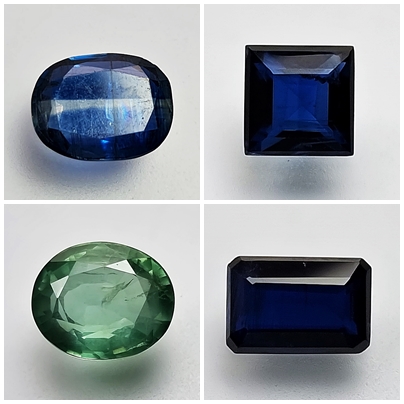Kyanite: Gemstone Information
Kyanite with andalusite and sillimanite (both q.v.) is a trimorph of Al2SiO5.It occurs as characteristic bladed and tabular triclinic crystals which are often bent or twisted. Lamellar twining is common. The hardness is markedly directional, 5.5 parallel to the long direction and 7 at right angles to it. There is one direction of perfect cleavage which leaves a pearly luster. The SG is 3.53–3.65 and the RI for the alpha, beta and gamma rays is 1.710–1.718, 1.719–1.724, 1.724–1.734, biaxial negative, birefringence 0.017. The color is green to blue-green, frequently zoned, with pleochroism near colorless, violet blue and cobalt blue or different shades of green.
Some bluish green kyanite may show an absorption line in the deep red at 701 nm and these and other specimens may also show two lines in the blue and a cut-off in the violet. Some dim red fluorescence may be seen under LWUV. Kyanite occurs in gneisses and schists and in granite pegmatites. The main sources of gem kyanite include Minas Gerais, Brazil, Machakos District, Kenya (some colorless specimens are reported as well as a fine blue; some striped crystals come from this source). Some dark blue specimens from Mozambique contain chromium and titanium. Faceable crystals have come from Yancy County, North Carolina, USA. A very fine deep sapphire-blue oval of 6.72ct was shown to MO’D by Marcus McCallum in December 2004.
Exploring the Mystique and Benefits of Kyanite Gemstone
Introduction:
Kyanite, with its captivating hue and mystical allure, stands out among the plethora of gemstones. Its name is derived from the Greek word ‘kuanos,’ meaning deep blue, aptly describing its most common color. Beyond its aesthetic appeal, kyanite holds a rich history and an array of benefits that have fascinated gem enthusiasts for centuries.
Formation and Characteristics:
Kyanite is a metamorphic mineral that forms under high-pressure conditions, typically within schists, gneisses, and quartz veins. It belongs to the silicate mineral family and exhibits a unique crystal structure, often occurring as elongated blades or fibrous masses. While blue is the most prevalent color, kyanite can also appear in shades of green, gray, black, and even colorless, depending on impurities present during formation.
Historical Significance:
Throughout history, kyanite has been revered for its metaphysical properties and ornamental value. Ancient civilizations believed it possessed mystical powers, associating it with communication, meditation, and spiritual enlightenment. The Greeks even fashioned kyanite into beads and amulets, believing it could foster tranquility and psychic abilities. In more recent times, kyanite has been utilized for its industrial applications, particularly in the manufacture of ceramics, refractory materials, and electronics.
Metaphysical Properties:
Kyanite is esteemed in the realm of crystal healing for its purported metaphysical properties. It is believed to align all chakras, facilitating energy flow and promoting balance within the body. Moreover, kyanite is thought to enhance psychic abilities, aid in meditation, and promote clarity of thought. It is often used by practitioners to alleviate stress, anxiety, and negative emotions, fostering a sense of tranquility and inner peace.
Physical and Emotional Benefits:
Beyond its metaphysical properties, kyanite is also associated with various physical and emotional benefits. It is believed to alleviate muscular and skeletal disorders, promoting healing and relieving pain. Additionally, kyanite is thought to enhance communication skills, foster self-expression, and encourage logical thinking. Its calming influence is said to alleviate tension and promote emotional stability, making it a valuable tool for those navigating challenging situations.
Spiritual Significance:
In spiritual practices, kyanite is revered as a stone of attunement, facilitating connection with higher realms and spiritual guides. It is believed to open pathways for communication with the divine, aiding in the interpretation of intuitive messages and enhancing spiritual insight. Kyanite’s soothing energy is said to create a conducive environment for meditation and inner exploration, fostering a deeper understanding of oneself and the universe.
Practical Uses:
Aside from its metaphysical and spiritual significance, kyanite also boasts practical applications. Its hardness and resilience make it a favored gemstone for jewelry, particularly in rings, earrings, and pendants. Kyanite’s vibrant colors and unique crystal formations lend themselves well to artisanal designs, appealing to both collectors and fashion enthusiasts. Furthermore, its industrial applications in ceramics, abrasives, and electronics underscore its versatility and economic value.
Conclusion:
In conclusion, kyanite stands as a gemstone of profound beauty, history, and metaphysical significance. From its mesmerizing hues to its purported healing properties, kyanite continues to captivate the imagination of gem enthusiasts worldwide. Whether admired for its ornamental value, utilized for its practical applications, or cherished for its spiritual attributes, kyanite remains a gemstone of enduring mystique and allure.





